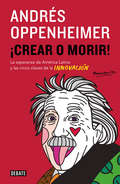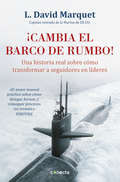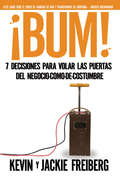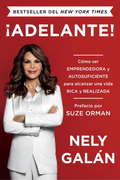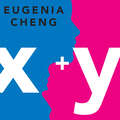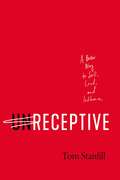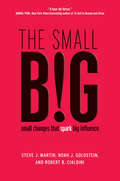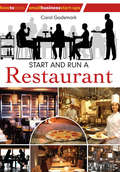- Table View
- List View
¡Crear o morir!: La esperanza de Latinoamérica y las cinco claves de la innovación
by Andrés OppenheimerCon un sorprendente optimismo sobre el futuro de América Latina, Andrés Oppenheimer revela en este libro las claves del éxito en el siglo XXI, en que la innovación y la creatividad serán los pilares del progreso. ¿Qué debemos hacer como personas y países para avanzar en la economÌa de la innovación? ¿Qué debemos hacer para producir innovadores de talla mundial, como Steve Jobs? Para averiguarlo, Oppenheimer el periodista latinoamericano más galardonado a escala internacional explora los secretos de las brillantes trayectorias de varios innovadores en la actualidad. Entre otros, analiza casos como el de Pep Guardiola, el entrenador de futbol que llevó al club Barcelona a su época más gloriosa; el chef Gastón Acurio, quien convirtió a la comida peruana en un motor de crecimiento económico; el estadounidense Bre Pettis, un ex profesor que está revolucionando la industria de las impresoras 3D, o Sir Richard Branson, el magnate británico que está creando una industria de turismo espacial. A partir de esas historias, con su lucidez y amenidad habitual, Oppenheimer extrae conclusiones concretas para ayudarnos a detonar el gran potencial creativo hispanoamericano. Comentarios sobre libros anteriores de Andrés Oppenheimer: "Oppenheimer ocupa un lugar único en la prensa de las Américas. Sus trabajos periodísticos fijan la agenda del debate político." -Le Monde- "Leer un libro como este de Andrés Oppenheimer es un bálsamo. Sacude nuestro provincialismo sin desanimarnos." -Fernando Henrique Cardoso, ex presidente de Brasil-
¡Cierre las brechas!: Diríjase a un desempeno mAs alto y ¡cons
by Ken Blanchard Dana Robinson«Si un desempeño pobre está atacando a su empresa, no se deje atrapar. Saque provecho de ¡Cierre las brechas!». —Harvey Mackay, autor del best seller del New York Times Nada entre tiburones sin que te coman vivo «Este libro describe un enfoque, un marco para la acción y unas herramientas que pueden mejorar el desempeño general de una compañía mediante su personal. Este es un libro que tanto los gerentes de Recursos Humanos como los supervisores inmediatos deben leer». —Mike Woerner, director de Recursos Humanos, Wawa, Inc. Gracias a sus clásicos empresariales, como El nuevo mánager al minuto y El autoliderazgo y el ejecutivo al minuto, el autor best seller Ken Blanchard se ha convertido en un gurú de los negocios reconocido nacionalmente que presenta nuevos enfoques revolucionarios sobre la gerencia, el liderazgo, el servicio al cliente y más. Ahora, Blanchard trabaja en equipo con Dana y Jim Robinson para enfrentar el problema crucial del desempeño humano en ¡Cierre las brechas!, una divertida parabola de negocios que combina el talento de Blanchard para contar historias con el enfoque pionero de los Robinson sobre la resolución de problemas. Los gerentes de todos los niveles que laboran en las organizaciones a menudo identifican un problema y se lanzan de inmediato a resolverlo. Sin embargo, muchas veces la solución no resuelve el problema, porque el gerente no descubrió la raíz del asunto. Blanchard y sus coautores están aquí para enseñarle a evitar que caiga en esta... trampa destructora. En ¡Cierre las brechas!, Bill Ambers, el director de servicio al cliente en una firma de alta tecnología, se encuentra con un problema en la empresa: su centro de llamadas no está alcanzando el número de llamadas estipulados. Con la ayuda de Michael St. Vincent, jardinero y legendario jefe de Saint’s Nurseries and Landscaping, aprende a cavar sistemáticamente hasta encontrar la raíz del problema, y al hacerlo descubre tanto el enfoque de BRECHAS en cuanto a mejorar el rendimiento y una herramienta llamada Cerrador de brechas. Con su fascinante historia, sus ejemplos vívidos y su enfoque amistoso hacia el lector, ¡Cierre las brechas! es de lectura obligatoria para todo aquel que busca identificar y corregir los factores que impactan negativamente el desempeño, de tal manera que el impacto determinante es significativo y mensurable.
¡Cambia el barco de rumbo!: Una historia real sobre cómo transformar a seguidores en líderes
by L. David MarquetUna historia real que demuestra que el liderazgo debería implicar delegar el control más que controlar, y crear líderes en lugar de seguidores. «El mejor manual práctico sobre cómo delegar, formar y conseguir procesos sin errores.»Fortune David Marquet, oficial de la Navy con una gran experiencia, estaba acostumbrado a dar órdenes. Cuando accedió al cargo de capitán del submarino nuclear USS Santa Fe, tenía bajo su mando a más de cien marines en las profundidades del mar. Marquet seguía el modelo tradicional de liderar el barco, hasta que un día, involuntariamente, dio una orden imposible y, pese a ello, su tripulación intentó cumplirla. Marquet descubrió entonces que estaba rodeado de seguidores, y que todos estarían en peligro hasta que no se produjera un cambio radical. ¡Cambia el barco de rumbo! es la historia real de cómo el Santa Fe, tras cuestionarse el tradicional modelo líder-seguidor de la Navy, pasó de ser el barco peor valorado de toda la flota a convertirse en el mejor de todos. Su tripulación empezó a sentirse plenamente comprometida y a desarrollar todo su potencial. Independientemente del lugar que ocupe en su empresa, usted también podrá aplicar el modelo de Marquet para cambiar radicalmente el rumbo de su barco. Su recompensa: una organización en la cual las personas asumen plenamente sus responsabilidades, y donde son, en definitiva, más felices.Reseñas:«No conozco un modelo mejor de liderazgo que el del capitán Marquet. En las páginas de este libro, tú también encontrarás un modelo para tus retos.»Stephen R. Covey, autor de Los 7 hábitos de la gente altamente efectiva «Lea ¡Cambia el barco de rumbo! y aprenderá a generar personas resistentes y comprometidas, deseosas de ponerse manos a la obra.»Almirante Thomas B. Fargo, U.S. Navy retirado, excomandante de la flota del Pacífico y presidente de Huntington Ingalls Industries «Esta es la historia del capitán David Marquet y de su aventura sin precedentes en uno de los ambientes más rígidos, a bordo del Santa Fe, un submarino nuclear de la Marina de los Estados Unidos. Tuvo el coraje de reformular su definición de liderazgo y obtuvo unos resultados revolucionarios; en cuestión de meses la tripulación pasó de ser la peor valorada a ser la mejor considerada.»Charlie Kim, fundador y CEO de Next Jump, Inc. «Este libro es un feliz cruce entre La caza del octubre rojo y la Harvard Bussiness School.»Joe Debono, fundador y presidente de MBA Corps y gestor de patrimonios en Merrill Lynch
¡Bum!
by Kevin FreibergDescubra las 7 elecciones que usted debe hacer.Ante usted hay una multitud de elecciones en espera de ser hechas. Estasdeterminarán su calidad de vida y la importancia de su contribución en el mundolaboral, si se convertirá en una persona verdaderamente indispensable o en unaque apenas será echadade menos. Durante los últimos veinte años, los doctores Kevin y Jackie Freiberghan fungido como asesores de rendimiento alrededor del mundo. En ¡Bum! se basan en su experiencia prácticapara mostrar cómo:Volverse indispensable en el trabajoInvolucrarse en tareas que valen la penaDejar de crear excusas por nuestras circunstanciasNo esperar que otros nos rescatenHacerse responsable y rendir cuentasConvertirse en las personas que Dios quiere que seamosEste es su llamado para ser libre. Es unainvitación a crear una comunidad de personas con la misma visión que juntascrearán organizaciones que pueden mover montañas.
¡Ayuda, mi trabajo apesta!
by Richard G Lowe Jr Marina Alonso FernándezUsted puede tomar el control y disfrutar de su trabajo ¿Está lidiando con un trabajo que está haciéndolo enfermo, perdiéndoles dinero y promociones o causando que se sienta mal y enojado? ¿Sientes que estás sin tu alma a la corporación? Ya sabes, un trabajo no se supone que sea así, y si eso es lo que se enfrenta, entonces es el momento para que usted tome algunas decisiones, enfrentar la situación y resolver lo que sucede. Créanme, sé por experiencia que es posible cambiar la situación en el trabajo. He pasado por todo y tenía jefes que, desde fantásticos hasta locos raving. Su trabajo puede afectar su estado mental, su cuerpo y su familia ¿Su trabajo lo está haciendo físicamente enfermo? ¿Te temes levantarse cada día porque tienes que ir a la oficina odiada? ¿Sólo te sientes vivo los fines de semana porque no tienes que ir a trabajar? ¿Es tu jefe un idiota que te acosa constantemente, negándote que te eleva y te hace miserable? ¿No sería mejor mirar adelante a ir a trabajar cada día? ¿Disfrutaría de un trabajo desafiante donde reciba un salario justo, se trate humanamente y con compasión, y donde reciba los recursos, la capacitación y la ayuda que necesita para tener éxito? Parece un sueño, ¿no? Trabajos como ese no existen en la vida real, ¿verdad? Obtener las respuestas de alguien que ha sido a través de todo Trabajé en trabajos insatisfactorios para los patrones que no cuidaron y no recompensarían servicio bueno y competente. Permanecí leal, ciegamente haciendo lo que me dijeron, obligado a estar de guardia 24x7, a trabajar sin la formación adecuada y los recursos, y meses sin un complemento o un agradecimiento. Sobreviví a través de pura fuerza de voluntad, determinación y una creencia en mí mismo y mis habilidades. Pero hay una mejor manera de tomar el abuso y ser una víctima de mala gestión, apoyo insuficiente, demandas irrazonables e inclu
¡Ayuda! ¡Mi Jefe Está Demente!
by Richard G Lowe Jr Aurora CarranzaMejora Tu Vida Laboral, Que Lleva a una Mejor Productividad, Potencialmente Grandes Aumentos y una Vida más Feliz. ¿Tu jefe de estás volviendo loco o te está acosando? ¿Él o ella está haciéndote sentir miserable, negándote aumentos y promociones, o analizando a detalle cada movimiento tuyo? ¿Estás feliz con tu situación laboral? ¿Comprendes que no mejorará a menos que hagas algo al respecto? ¿Preferirías anhelar ir a trabajar cada día? ¿No te gustaría ser respetado, hacer más dinero e ir a casa satisfecho por haber hecho un buen trabajo? He estado donde tú estás hoy. En mi vida, he tenido todo tipo de administradores, desde un jefe que fue declarado loco hasta el compulsivo que analizaba todos los detalles y, el peor de todos, el gerente que iba a jubilarse y no quería aprobar o hacer nada que pudiera afectar a la empresa. Me he sentido atacado, despreciado, no valorado y abrumado, algunas veces todas al mismo tiempo. Estas situaciones afectaron mi salud y mi bienestar y causaron una sensación de impotencia y depresión que nada parecía arreglar. La vida parecía no ser nada más que fallas debido a las constantes invalidaciones y negatividad. Finalmente, me di cuenta de que podía hacer algo sobre el jefe demente. Había muchas opciones, desde una conversación simple hasta el encontrar un nuevo empleo. Lo que me di cuenta es que se necesitan a dos para ser una víctima –el victimario (el jefe demente) y la víctima. Decidí romper esa loca danza. * Comprende que puedes hacer algo para corregir esa situación. * Aprende las muchas opciones a tu alcance. * Crea una ruta de escape para usarla si la situación no mejora. * Encuentra a las personas que pueden ayudarte a tomar acción correctiva. No permitas que pase un día más sin tomar acción para patear al jefe demente en el trasero. Obtén tu copia de este libro AHORA. ¡Sube en esta página y selecciona el botón de COM
¡Arriésgate!
by Mario BorghinoTransfórmate en quien siempre has querido. Si deseas cambiar lo que sucede en tu día a día, primero debes comenzar a trabajar en ti mismo, porque las respuestas a tus preguntas siempre están en tu interior. En ¡Arriésgate! descubrirás un método para hacerte preguntas que irán dirigidas a cuatro áreas de especialización que tiene tu cerebro: mente racional, mente creativa, mente emocional y cerebro reptiliano. En cada capítulo cuestionarás de manera integral tu forma de ser para cambiar tus creencias limitantes y los miedos a tus nuevos desafíos. Mario Borghino te invita a transformar tu mente para alcanzar el enorme poder que hay en ti. Con sus reflexiones encontrarás el coraje para lanzarte al abismo de las oportunidades que has postergado y convertirte en quien siempre has querido. Si te arriesgas en la vida puedes perder, pero si no luchas habrás perdido todo, porque tu éxito es convertirte en quien verdaderamente eres.
¡Adelante!: Cómo ser emprendedora y autosuficiente para alcanzar una vida rica y realizada
by Suze Orman Nely GalánUna revolución mundial del espíritu emprendedor está en marcha. Para Nely Galán --empresaria, productora de TV y magnate de bienes raíces-- ayudar a mujeres a volverse emprendedoras y autosuficientes es una misión. ¿Y qué es ser una mujer rica y exitosa? Significa ser rica en todos los sentidos: rica en dinero, rica en familia, rica en amor, rica en tiempo: ¡es abundancia! Galán lo dice todo de frente, sin tapujos, compartiendo valiosos consejos francos y sensatos como: * "El Príncipe Azul no existe": Ningún marido te va a rescatar, tu jefe no es tu héroe. Primero, ¡elígete tú! * "Piensa como inmigrante": Ahorra, ahorra y luego, ahorra todavía más. No gastes dinero que no tienes, mantén tus metas a la vista para gastar dentro de tus límites. * "No compres zapatos, compra propiedades": Olvídate de la gratificación inmediata. Prueba con una orientación por metas. Sueña en grande, rompe el cascarón y descubre una idea ambiciosa, adopta una visión para tu vida. * "El poder no te lo entregan en bandeja de plata, tienes que tomarlo": Escucha tu voz interior pero mantén la mente abierta para escuchar un buen consejo. Desafíate tú misma e identifica mentores. ¡Adelante! también presenta inspiradoras historias de mujeres exitosas, ejercicios para identificar tus metas y tus fortalezas, así como consejos prácticos y pequeños trucos para ahorrar dinero, hacer dinero y encontrar "dineros escondidos" que puedan contribuir a poner en acción tus sueños de trabajar por cuenta propia. Así que únete al movimiento ¡Adelante! La revolución empieza dentro de ti. "Un libro sabio y muy necesario que enseña a las mujeres a no temerle al dinero sino a verlo como una forma hacer realidad sus sueños".--Sandra Cisneros "Sé de primera mano que Nely Galán es una máxima empresaria y tu mejor amiga. La generosidad de su espíritu salta de las páginas de este libro".--Nell Merlino, fundadora de Count Me In for Women's Economic Independence, una organización para mujeres empresarias "¡Adelante! enseña a las mujeres a liberar su pasión y lanzarse a tomar acción para alcanzar su éxito. Nely inspira a sus lectoras a usar lo que tienen para conseguir lo que quieren".--Tory Johnson, autora de The Shift, bestseller #1 del New York Times "Tú no estarás completa hasta que te sientes realizada en todo aspecto de tu vida y tu dinero. Y eso es lo que más va a impactar el futuro de tus hijos".--Maria Elena Lagomasino, presidenta de WE Family Offices y miembra de la junta directiva de Walt Disney, Coca-Cola y AvonFrom the Trade Paperback edition.
x+y: A mathematician's manifesto for rethinking gender
by Eugenia ChengScience and maths have never been the preserve of lone geniuses: collaboration has always been at the heart of intellectual endeavour. But to this day, men like Einstein remain the pervasive archetype of genius, and the intellectual contributions of women past and present have gone unacknowledged. x+y is one mathematician's manifesto for how we can fix that - and why that requires rethinking how we think about thinking itself.In her illuminating new book, Royal Society Book Prize finalist Eugenia Cheng reveals how mathematics can help us escape gendered stereotypes by giving us new structures based on character, not gender. By reframing intellectual endeavour beyond the myth of the lone genius, she shows that the real key to success is thinking more collaboratively. Through her radical new framework for understanding traditional ideas about gender and thinking, Cheng shows us how one small but powerful change to the way we think could make the world a better place for men and women alike.
upGrad: Delivering Career Outcomes Online: Degree by Degree
by Anjali Raina John Jong-Hyun Kim Rachna ChawlaIn August 2021, the founders of upGrad, the latest unicorn in the Indian higher education online space, were deciding how to best use the funds to execute on their ambitious growth plans. Ronnie Screwvala, Mayank Kumar and Phalgun Kompalli had envisioned upGrad as an online education platform to enable working professionals to access university degrees from around the world. The pandemic induced lockdowns that confined millions to their homes due to COVID-19, supercharged the growth of upGrad, and indeed all online higher education providers, leading to both growth and competition. The founders of upGrad were keen to ensure they would continue to be a winner in the evolving sector - but which route should they prioritize? Should upGrad continue to focus on offering academic credentials through university partnerships to working professionals, or strengthen their position in the college learners (aged 18 to 23) segment by offering job-oriented test prep and bachelor's degrees?
unReceptive: A Better Way to Sell, Lead, and Influence
by Tom StanfillLearn the secret to making the hard sell, easy.A large and growing number of people are distracted, overwhelmed, and isolated today and this has resulted in a steep decline in receptivity to another sales pitch, call, or email. And the harder you try to sell, the greater the resistance. Unreceptive reveals the surprisingly simple and refreshing solution to this problem that is a sharp contrast to traditional approaches to selling, revealing why the receptivity of an audience is far more important than the power of the message.In this groundbreaking new guide, Tom Stanfill shares his proven methodology, road- tested over decades by hundreds of thousands of sales professionals, workshop participants, and industry experts, on how to convert even the most disinterested prospects and customers. This book will show you how to:Eliminate resistance and make selling easy and enjoyable, while experiencing a deeper sense of purpose.Overcome the five receptivity barriers – the customer&’s perception of you, opening a &“closed&” door, uncovering the unfiltered truth, changing beliefs, and motivating the customer to take action.Adopt the tested and true operating system used by the most persuasive and influential people. When you shift the focus from crafting the perfect message to creating receptivity, you flip the entire art of selling on its head and form lasting relationships that set you and your customers up for lasting success.
uberPOOL
by Marco Iansiti Amram Migdal Michael W. ToffelThis case describes Uber's uberPOOL service, which let multiple Uber users who were headed in the same direction share a ride and pay substantially lower fares.
uBiome
by Thomas R. Eisenmann Olivia GrahamuBiome provided clinical tests that sequenced the DNA of human microbiome samples, providing data on health conditions directly to consumers or to prescribing physicians. Founded in 2012, the San Francisco-based startup raised $105 million from top-tier venture capital firms and recruited prominent biotech executives and scientists as board members and advisors. In April 2019, the FBI raided uBiome's offices to investigate claims that the company had repeatedly billed individuals without their consent to meet aggressive revenue targets. uBiome's cofounders/co-CEOs resigned soon afterward. The company declared bankruptcy later that year after a board committee concluded that management had indeed pursued policies of questionable legality, including improper insurance billing practices, improper use of a telemedicine physician network, overly aggressive marketing tactics, and the presentation of misleading information in fundraising pitches.
thredUP: Think Secondhand First
by Thomas R. Eisenmann Allison M. Ciechanover Jeff HuizingaIn the fall of 2016, the management team at thredUP, the largest U.S. online retailer of secondhand clothing, is deciding whether to expand into international markets. Over the past 12 months the 7-year old startup, which had raised over $130 million in venture capital, had seen revenue grow 100% and gross margin double. Would moving abroad expand thredUP's total addressable market and help position the company for an IPO? Or would it prove a distraction, derailing momentum in the core U.S. business?
thredUP: Think Secondhand First
by Thomas R. Eisenmann Allison M. Ciechanover Jeff HuizingaIn the fall of 2016, the management team at thredUP, the largest U.S. online retailer of secondhand clothing, is deciding whether to expand into international markets. Over the past 12 months the 7-year old startup, which had raised over $130 million in venture capital, had seen revenue grow 100% and gross margin double. Would moving abroad expand thredUP's total addressable market and help position the company for an IPO? Or would it prove a distraction, derailing momentum in the core U.S. business?
the small BIG: small changes that spark big influence
by Steve J. Martin Noah Goldstein Robert CialdiniAt some point today you will have to influence or persuade someone - your boss, a co-worker, a customer, client, spouse, your kids, or even your friends. What is the smallest change you can make to your request, proposal or situation that will lead to the biggest difference in the outcome?In the small Big three heavyweights from the world of persuasion science and practice -- Steve Martin, Noah Goldstein and Robert Cialdini -- describe how, in today's information overloaded and stimulation saturated world, increasingly it is the small changes that you make that lead to the biggest differences.In the last few years more and more research - from fields such as neuroscience, cognitive psychology, social psychology, and behavioral economics - has helped to uncover an even greater understanding of how influence, persuasion and behavior change happens. Increasingly we are learning that it is not information per se that leads people to make decisions, but the context in which that information is presented.Drawing from extensive research in the new science of persuasion, the authors present lots of small changes (over 50 in fact) that can bring about momentous shifts in results. It turns out that anyone can significantly increase his or her ability to influence and persuade others, not by informing or educating people into change but instead by simply making small shifts in approach that link to deeply felt human motivations.
sweetriot 2.0
by Christopher Marquis Bobbi Thomason Donna KhalifeIn the fall of 2010, Sarah Endline, CEO and Founder of sweetriot, an organic chocolate company, was deciding the best way to grow her organic chocolate company, while keeping her chocolate physically and conceptually on the shelf. She wanted to grow the offerings and profits of her company, while maintaining its social mission and unique flair. The case tracks the origins of sweetriot from Sarah's formative early career experiences, to the company's launch and beyond as Sarah prepares future products, establishes production channels, and seeks future funding. Sarah was not content to just be a small New York City candy company. Her goal was for sweetriot to be the number one natural chocolate company in the world and to thus be a vehicle to drive change globally. How can she meet that objective while also keeping the company true to its social roots?
start And Run A Restaurant
by Carol GodsmarkThis book covers all apsects of the restaurant business - from initial start-up, to building up a regular trade. Running a restaurant can be a most rewarding and stimulating business - both on the personal and financial level, if you approach it with professionalism and dedication, together with inagination and flair. This book is full of up-to-date information for the aspiring or novice restaurateur, as well as those already in the business and striving to meet customer expectations. It covers: - Business and financial planning - Getting planning permission - Planning, designing and equipping the kitchen and restaurant - Dealing with environmental health officers and their required standards - Choosing a name, marketing the business and getting into guides - Planning the menu and choosing your suppliers You'll find all you need to know for the day-to-day running of the restaurant, plus tips from several experienced restaurateurs.
smartWorkLife - Bewusst erholen statt grenzenlos gestresst: Flexibel und gesund arbeiten in New Ways of Working
by Martina Hartner-Tiefenthaler Simone Polic-Tögel Maria Magdalena MayerKönnen wir autonom und flexibel arbeiten, ohne auszubrennen? Dürfen berufliche und private Grenzen im Homeoffice verschwimmen? Welche persönlichen und organisationalen Ressourcen unterstützen uns beim Umgang mit den Herausforderungen im Homeoffice? Welche Rolle spielt dabei die Führungskraft?Das sind nur einige Fragen, wenn es um New Ways of Working und dem Arbeiten im Homeoffice geht. Die Autorinnen liefern durch ihre wissenschaftliche Expertise spannende Antworten auf diese brennenden Fragen unserer Zeit. Sie verbinden in diesem Buch auf sehr anschauliche Weise die Themenfelder Arbeitsautonomie, Digitalisierung, Vermischung von Arbeit und Privatleben, Ressourcenerhaltung sowie organisationale Rahmenbedingungen von flexibler Arbeit – praxisnah und evidenzbasiert.Ein hochaktueller Leitfaden für die Arbeitswelt von morgen – empfehlenswert für Studierende und Lehrende, Angestellte und Führungskräfte, Personal- und Gesundheitsmanager*innen sowie Betriebsräte und Berater*innen.
slide:ology - Oder die Kunst, brillante Praesentationen zu entwickeln
by Nancy DuarteWie viele Präsentationen haben Sie in Ihrem Berufsleben bereits verfolgt? Und Hand aufs Herz: Wie viele davon haben einen bleibenden Eindruck bei Ihnen hinterlassen? Wirklich gute Präsentationen sind noch immer die Ausnahme, denn nur selten werden die Möglichkeiten dieses Mediums optimal genutzt. Wer sein Publikum nachhaltig überzeugen möchte, muss seine Ideen verdichten und in stimmige Bilder umsetzen. slide:ology setzt hier an und führt Sie in die Kunst des visuellen Erzählens ein. Die Autorin Nancy Duarte weiß, wovon sie spricht: Sie leitet Duarte Design, das Unternehmen, das unter anderem die Slide-Show in Al Gores Oscar-prämiertem Film Eine unbequeme Wahrheit entwickelt hat. In slide:ology gewährt sie tiefe Einblicke in ihr umfangreiches Wissen als Designerin. Anhand von Fallstudien bringt sie Ihnen darüber hinaus die Visualisierungsstrategien einiger der erfolgreichsten Unternehmen der Welt nahe. slide:ology zeigt Ihnen unter anderem, wie Sie: - Ihr Publikum gezielt ansprechen - Ihre Ideen auf den Punkt bringen und ein stimmiges Design entwickeln - Ihre Aussagen mit Farben, Bildern und prägnantem Text unterstützen - Grafiken erstellen, die Ihren Zuhörern das Verständnis erleichtern - Präsentationstechnologien optimal nutzen
salaUno: Eliminating Needless Blindness in Mexico
by Richard G. Hamermesh Regina Garcia Cuellar Valeria MoyIn May 2013 the co-founders and co-CEOs of salaUno, Javier Okhuysen and Carlos Orellana, were encouraged by the results of their fledgling start-up. salaUno was founded as a for-profit enterprise in order to have the capital needed for rapid growth and to fulfill its mission of Eliminating Needless Blindness in Mexico. salaUno had grown from doing 75 cataract surgeries in its first month of operation to a high of 388 surgeries 21 months later. This case explores the challenges in scaling up a healthcare venture within a developing country.
red helicopter—a parable for our times: lead change with kindness (plus a little math)
by James RheeA NATIONAL BESTSELLEREmbrace your agency, lead change, and fly free—in the business of life and the life of business—with kindness (plus a little math)In kindergarten, James Rhee received a toy red helicopter in gratitude for a simple act of generosity—sharing his lunch. Decades later, the lesson from that small gift led him to develop a human-centered framework for business and personal achievement that helped him overcome seemingly insurmountable hurdles and find unprecedented success.“red helicopter is a transformative experience. James Rhee's story is a must read for anyone, of any age, who wishes to think, act, and lead with balance, agility, and wisdom." —Jay ShettyRhee was a high school teacher turned private equity investor when he unexpectedly took the helm of Ashley Stewart, an iconic company predominantly employing and serving Black women. Inspired by the values his dying Korean immigrant parents instilled in him, he knew that a radically different—yet familiar—approach was required to lead this twice-bankrupt company from certain liquidation to true transcendence.Is it possible to be successful and kind? To lead with precision and compassion? To honor who we are in all areas of our lives?The entire world bet against him and Ashley, but Rhee trusted his instincts to identify, measure, and leverage the intangible goodwill at the company’s core, a decision which ultimately multiplied its fortunes several times over.Anyone can combine the clarity and imagination we had as children with fundamental business metrics. Anyone can apply this refreshingly intuitive approach to lead change at work and at home. While eloquently sharing a story of personal and professional success, red helicopter presents a comforting yet bold solution to the dissatisfaction and worry we all feel in a chaotic and sometimes terrifying world.The insights and knowledge that Rhee imparts have been accumulated over decades of investing and leading at the highest levels of business. Drawing on this experience, he encourages us to trust the wisdom deep inside each of us so we can learn how to:Create and measure “goodwill,” the ultimate collective goodDiscover agency and the truth about kindness it entailsIdentify the invisible obstacles standing in your wayLead transformational change through small, scalable actsConstruct an accurate “balance sheet” of our assets and liabilitiesReorient our lives, organizations, and the world to reflect the best in usAre you looking for a sustainable balance between life, money, and joy? For yourself and others?Imagine, a clear path forward told as a deeply felt human story. A poignant and uplifting celebration of humanity, red helicopter—a parable for our times is a tale of struggle and triumph, compelling for its honesty and relatability as much as for the instructions we can all use to balance the books of our lives.red helicopter—a parable for our times features approximately 20 original illustrations by Korean artist Heyon Cho.
reMarkable: e-Writing the Future
by Elie Ofek Curtis HsuMagnus Wanberg is the creator of reMarkable, a breakthrough e-writer device set apart from similar products on the market by having solved the frustrating "slow ink" problem typically experienced on pen-based electronic devices, thus providing a "pen and paper" like experience. Moreover, the device allowed for the convenient and non-eye-straining reading of typical documents. Though enthusiastically received by several investors, there was still a long way to go before the prototype could reach a final commercial product. Wanberg and his team narrowed down the relevant market to three main segments: creative professionals, working professionals and students. However, these segments were seemingly at odds with each other in terms of which product attributes would most appeal to each. The young company therefore had to choose which group to target as this would dictate future product development efforts. With the planned launch date quickly approaching, the target market selected also impacted communication, channels, and pricing decisions. reMarkable had to resolve these matters while juggling limited time, effort and funds.
